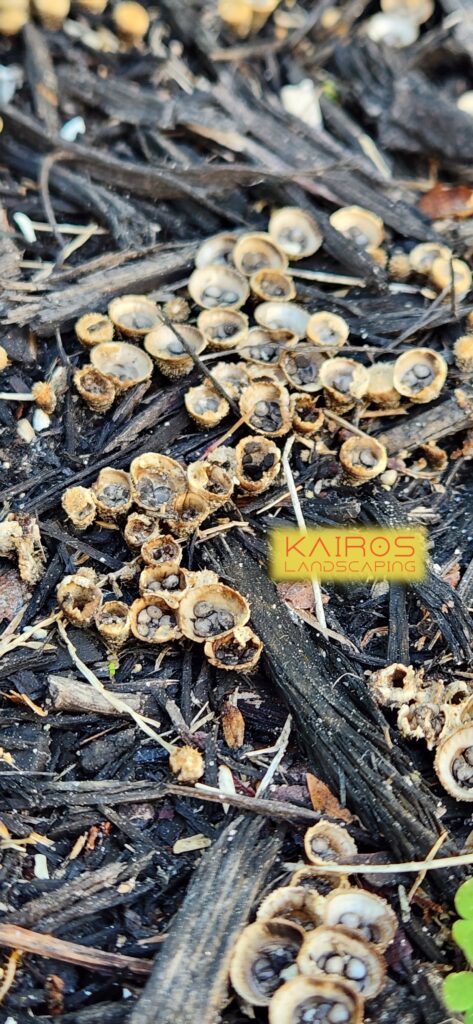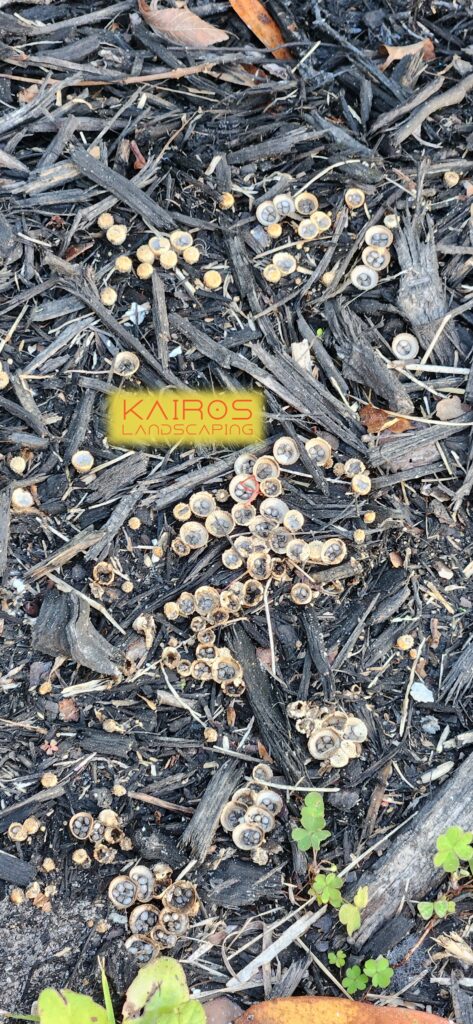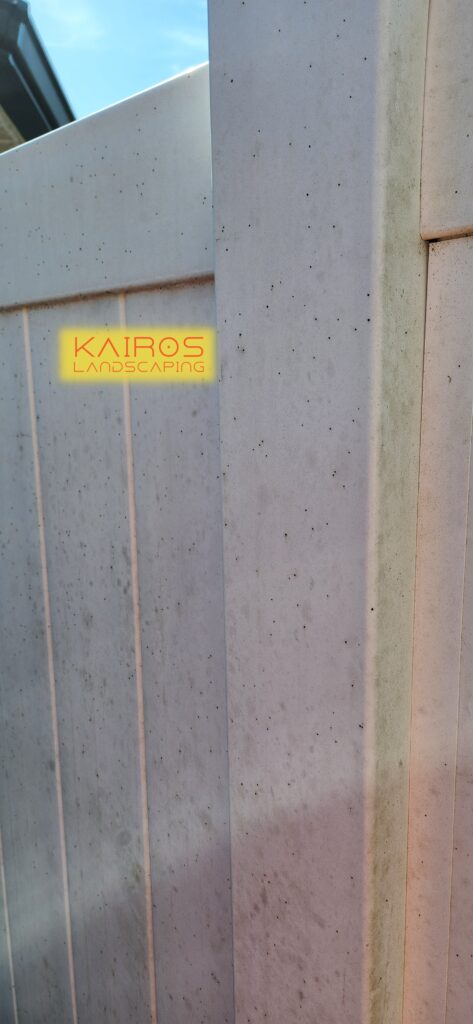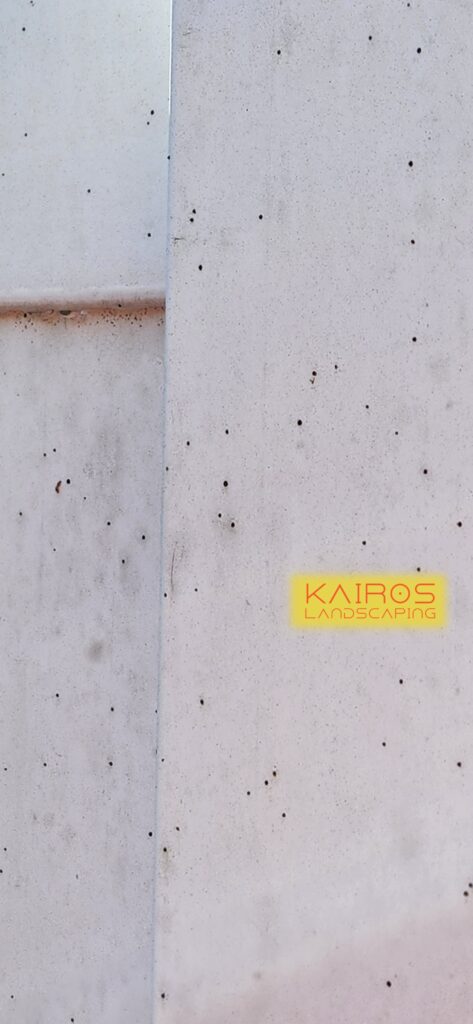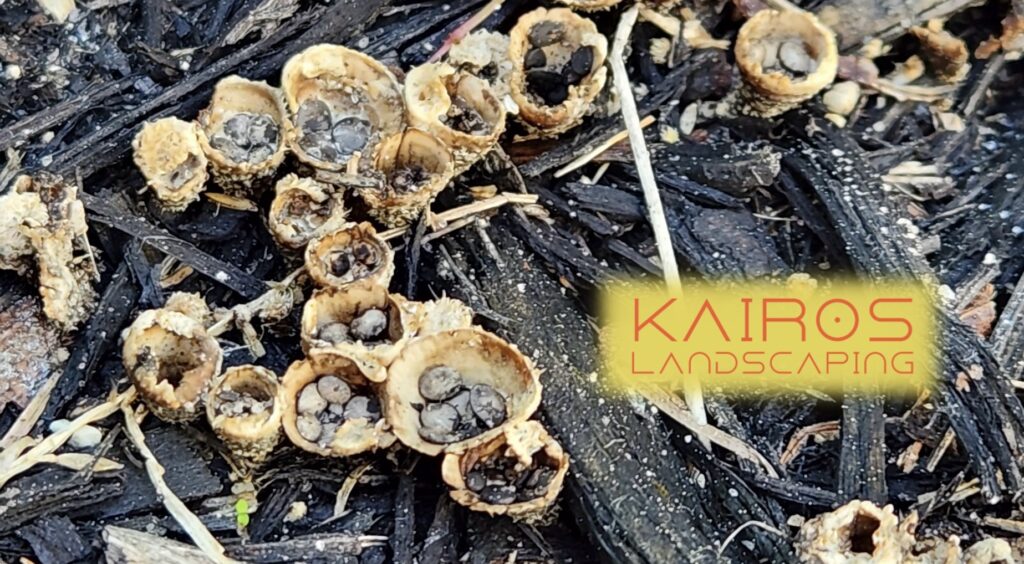Artillery Fungus
What is it?
Why is it in my landscape?
What does it do?
Does it hurt anything? Why you should care.
Can I do anything about it?
Artillery fungus is one of the millions of fungi that exist in the world, from brain controlling “Zombie Fungus” that make insects do wild things out of the control of their own decisions, to the edible Chicken of the Woods while foraging for something that may make that weeknight meal all the more exciting because you can’t find it in the grocery store. Artillery fungus is an interesting fungus as they look like barnacles in the landscape, feasting on, and breaking down wood in highly moist environments. They may not stand out themselves, but they do have some gnarly signs that make themselves well known – and not in a good way.
The Kingdom Fungi has many ways of expressing itself, and one can dedicate their entire life to studying its inhabitants and wouldn’t even scratch the surface; the artillery fungus, on the other hand, makes itself known on all the surfaces surrounding its area, up to a 20 foot radius and 15 feet high. This pesky little problem has the potential to cause thousands of dollars in damages, as it propagates itself in a way that, once noticed, can’t be removed without damage to the surface upon which its spores land. As you see in the photo we took on one of our client’s properties, we did a small scratch test to see if the small, 1-2mm specks could be removed. No dice.
Think of all the surfaces one little cluster of artillery fungus could cause damage to, from nice cars to vinyl fencing, and freshly painted houses, the artillery fungus actually has an aim. It can’t “see”, per say, but an argument can be made that it can send thousands of glebal masses, called peridioles, skyward, onto surfaces which reflect the most light. Imagine a prized, classic cream colored mustang, or having to have your stingray corvette repainted. Do you think the average booth sprayer can handle the details of your white G Wagon? The fruiting bodies shoot the tiny masses airborne, and being phototropic, they violently expelled in the general direction of the strongest sources of light within their range.
One might see why these little snot rockets might be a problem…
So, what can you do about it? Hire us to remove your mulch and put down the right substrate. Just kidding, but not really. Seriously, and in all actuality, IPM strategies should be employed. What’s IPM? That’s a great question – I knew all you readers were a savvy crowd. IPM stands for integrated pest management, something we bring from the beekeeping world to manage the stability of our apiaries in the west volusia area. IPM, in short, is taking small, collective measures that add up to more than the sum of its inputs to manage pests. HOPEFULLY, instead of using an atomic bomb to treat a problem, we can take small, preventative steps to eliminate, but hopefully avoid, a problem. Think: Jason Bourne, strike with accuracy and low impact to the surrounding area.
The artillery fungus needs this approach since there is no known way to eliminate it. There is no way to kill it, or eliminate its “offspring,” if you will. If it’s there, it will always be. The key to dealing with it is to focus on its environment, making sure to understand the reason it’s there in the first place. By the way, this is one of the key differences between how Kairos Landscaping operates, and the other professionals in the area we serve. This fungus, small, but mighty, has its weaknesses. For one, what does it feed on? What environment does it thrive in?
Water.
Light.
Food.
These are three components to the survival and thrival of the fungus we respect, but hate to see. It’s ugly. It’s messy. We think it contributes to the greater good of a healthy environment – where it belongs but is not your valuable property. Eliminate the food source, its “comfort”, and what it can see, and voila, you’re well on your way to success. Since the shotgun fungus, another known name for it, thrives in wet, high light environments, consider your irrigation (or, in some cases, the dripping of the condensate from the AC line during the summer): are your sprinklers watering a lot of your mulch? We’ve seen a lot of this in our client’s yards, a bunch of sprinklers that water where plants once were, but no longer exist from neglect or other factors; the wrong sprinklers, too. Why use sprayers when drip emitters will do? It saves on water and eliminates the moist environment – a double banger. This is why we do irrigation conversions from sprayer to drip emitters, to help our clients’ investments last longer – something to consider when hiring us to install your mulch, which can get costly if it’s done wrong – yes, mulch can be installed wrong.
Another consideration is to keep the right type of mulch. This can be tricky, with the preference of our client, to the best use product for a Florida Friendly Landscape https://ffl.ifas.ufl.edu/. Rock is great because it provides no food source for the funky fungi, but it gets weeds in it within the year of installation, and the go-to solution for weeds in rocks is herbicides – a risk to everyone’s health and detrimental to the environment, even if the Monsanto executive in the FDA office in Washington DC says it’s safe. Rocks also heat up too much causing damage to plants, and an increase in power consumption to keep your home cool, and if the landscaper didn’t put the proper weed fabric, which they should have procured from a proper agricultural supply house (where they’d need proper paperwork to do business with them), the rocks can sink into the soil below, making for a messy install and a loss of money (rock is super expensive) because the sand washes up, and the rock washes down. We see the barnacle-like masses in the colored, shredded mulch – you know the red, black, and brown cypress mulch? It also doesn’t look good past a year in Florida’s harsh sunlight, even if it’s advertised to stand up against the UV rays. If artillery fungus has been spotted in your landscape, the best option we’ve found is to use a mulch that is 85% bark or more, such as pine bark, and we are currently exploring leaves, including pine needles, as mulch.
Of all the products that you decide to use for mulch, an important consideration is to walk your property: what places are out of site? Are you paying attention? The ol’ adage of “out of sight, out of mind” rings true when keeping up with the tasks of a home – something you get from us when you hire us for quarterly property maintenance, or for our regular, yearly round lawn maintenance. We recommend looking at what you’ve got, and asking, “What story is my property telling me?” And go from there. Your smartphone is a valuable tool since you can snap a photo and share it to google images for instant feedback. Do you have weeds that show high or low H2O presence? Dollar weed shows where there is a lot of water. Pusley shows there is not enough water. Dandelions show there is a lack of calcium.
To wrap it all up, consider the area in which you live. Keep in mind what you have already. If you spot artillery fungus, keep calm, relax, its easy to know, now, what to do – call us! But if that’s not in the budget, we’re still here to help, especially through this blog forum, to make sure you have the information to arm yourself against artillery fungus, and more. It’s gonna do what it does, so our job (as humans) is to work with what God designed His creation to do. No rock unless you know you can maintain it and afford it. No shredded wood unless you know you don’t have artillery fungus, or, if you do, and you spot it and don’t want to remove it, cover the fungus to tide you over, blocking the light it aims to shoot towards. Remember the key components of the fungi’s survival mechanisms and remove what it needs to survive. All in all, if you spot it, you got it, and you’ll need to consider other options while you get things back in order – replace the mulch, repaint the house, vinyl fencing (pictured here) may benefit from pressure washing, but it may not be enough, or the pressure washing may cause damage if the glebal masses have hardened on the fence surface. Whatever your budget will allow, financially or chronologically. We hope that you’ve gotten some value from our blog, and if you have any questions, feel free to contact us with the method of your choosing – phone, email, or carrier pigeon.
TLDR answer below:
What is it? A barnacle shaped fungus in your shredded mulch.
Why is it in my landscape? It’s too wet, and too bright.
What does it do? It shoots tiny black masses 20 feet out and 15 feet high.
Does it hurt anything? Why should you care? You have to consider your tolerance for those ugly little specks all over your stuff. It won’t hurt anyone, but it isn’t exactly eye candy.
Can I do anything about it? Remove the mulch that is infected with it, then use something else – pine bark, pine needles, rock (rock not recommended).
Sphaerobolus stellatus–The Artillery Fungus
https://portal.ct.gov/caes/fact-sheets/plant-pathology/sphaerobolus-stellatus–the-artillery-fungus
Artillery Fungus-Small but Mighty https://blogs.ifas.ufl.edu/sumterco/2019/10/29/artillery-fungus-small-but-mighty/#:~:text=Artillery%20fungus%20covers%20hardwood%20mulch,because%20it%20prefers%20cooler%20temperatures.
Artillery fungus and other things that grow in hardwood mulch https://www.udel.edu/canr/cooperative-extension/fact-sheets/artillery-fungus-mulch/
Artillery Fungus: Identification and Prevention https://www.thespruce.com/artillery-fungus-identification-prevention-5185963
How the Zombie Fungus Takes Over Ants’ Bodies to Control Their Minds https://www.theatlantic.com/science/archive/2017/11/how-the-zombie-fungus-takes-over-ants-bodies-to-control-their-minds/545864/
Artillery Fungus (Sphaerobolus stellatus). https://msu-prod.dotcmscloud.com/resources/artillery-fungus-sphaerobolus-stellatus#:~:text=The%20dark%20spots%20are%201,fruiting%20bodies%20of%20the%20fungus.
